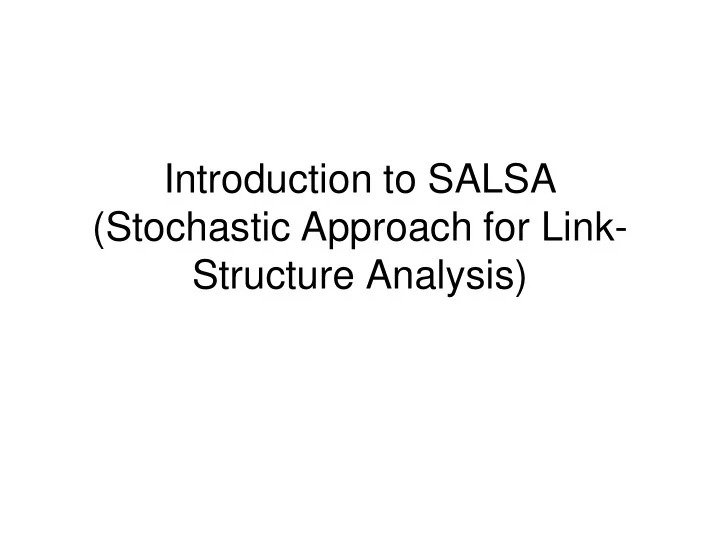

Introduction to SALSA (Stochastic Approach for Link- Structure Analysis)
• A fundamental problem in information retrieval is ranking. • Web search engines have a number of additional features at their disposal, including the hyperlinks leading from one web page to another. • A hyperlink can be viewed as an endorsement by a web page’s author of another web page.
• Link-based ranking algorithms can be broadly grouped into two classes: – Query independent algorithms that estimate the quality of a web page, and – Query-dependent ones that estimate its relevance to a particular query. • Recent research has shown that query- dependent link-based ranking algorithms (notably, the SALSA algorithm) are substantially more effective than well-known query- independent ones such as PageRank.
• In the mid-1990s, Jon Kleinberg proposed an algorithm called Hypertext-Induced Topic Search or HITS for short. • HITS is a query-dependent algorithm: It views the documents in the result set as a set of nodes in the web graph; it adds some nodes in the immediate neighborhood in the graph to form a base set , it projects the base set onto the full web graph to form a neighborhood graph, and finally it computes two scores, a hub score and an authority score, for each node in the neighborhood graph. • The authority score estimates how relevant a page is to the query that produced the result set; the hub score estimates whether a page contains valuable links to authoritative pages. • Authority and hub scores mutually enforce each other
• SALSA is a variation of Kleinberg’s algorithm. • takes a result set R as input, and constructs a neighborhood graph from R in precisely the same way as HITS. • Similarly, it computes an authority and a hub score for each vertex in the neighborhood graph, and these scores can be viewed as the principal eigenvectors of two matrices. • However, instead of using the straight adjacency matrix that HITS uses, SALSA weighs the entries according to their in and out-degrees.
• The approach is based upon the theory of Markov chains, and relies on the stochastic properties of random walks performed on our collection of pages. • The input to our scheme consists of a collection of pages C which is built around a topic t. • Intuition suggests that authoritative pages on topic t should be visible from many pages in the subgraph induced by C. Thus, a random walk on this subgraph will visit t -authorities with high probability.
Formal Definition of SALSA • Let us build a bipartite undirected graph G = (Vh, Va, E) from our page collection and its link-structure: – Vh = {sh|S є C and out-degree(s) > 0} (the hub side of G). – Va = {sa|S є C and in-degree(s) > 0} (the authority side of G). – E = {(sh, ra)|s 3 r in C}. Each non-isolated page s є C is represented in G by one or both of • the nodes sh and sa. Each WWW link s => r is represented by an undirected edge connecting sh and ra. • On this bipartite graph we will perform two distinct random walks. Each walk will only visit nodes from one of the two sides of the graph.
• We will examine the two different Markov chains which correspond to these random walks: – the chain of the visits to the authority side – the chain of the visits to the hub side • The hub matrix is defined as: ∑ ( 1 / deg( )).( 1 / deg( )) i k hi,j = a h ∈ } { | ( , ), ( , ) k k i k j G h a h a
• The authority matrix is defined as: ∑ ( 1 / deg( )).( 1 / deg( )) ai,j = i k a h ∈ { | ( , ), ( , ) } k k i k j G h a h a A positive transition probability a(i, j) > 0 implies that a certain page k points to both pages i and j, and hence page j is reachable from page i by two steps: retracting along the link k -> i and then following the link k -> j.
• Let W be the adjacency matrix of the directed graph defined by and its link structure. • Denote by Wr the matrix which results by dividing each nonzero entry of W by the sum of the entries in its row, and by Wc the matrix which results by dividing each nonzero element of W by the sum of the entries in its column. • H consists of the nonzero rows and columns of T , and A consists of the nonzero rows and W r W c T W r . columns of W c
Recommend
More recommend